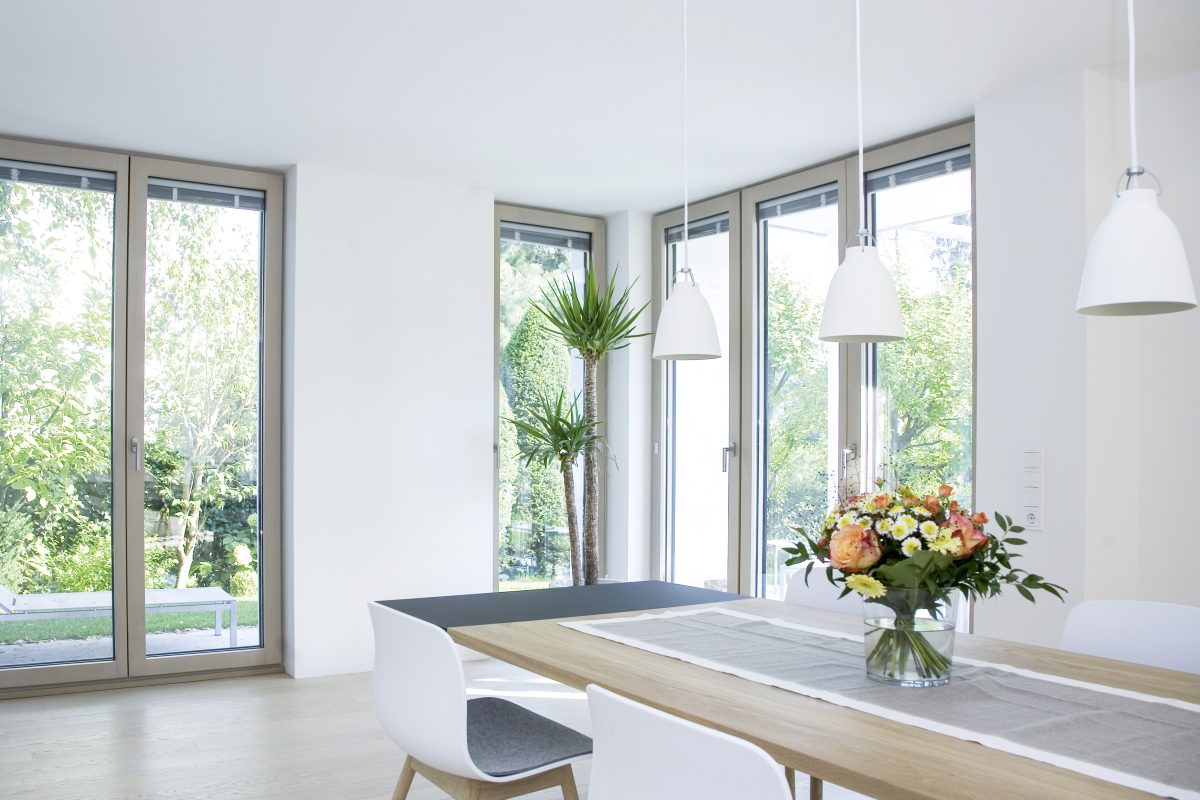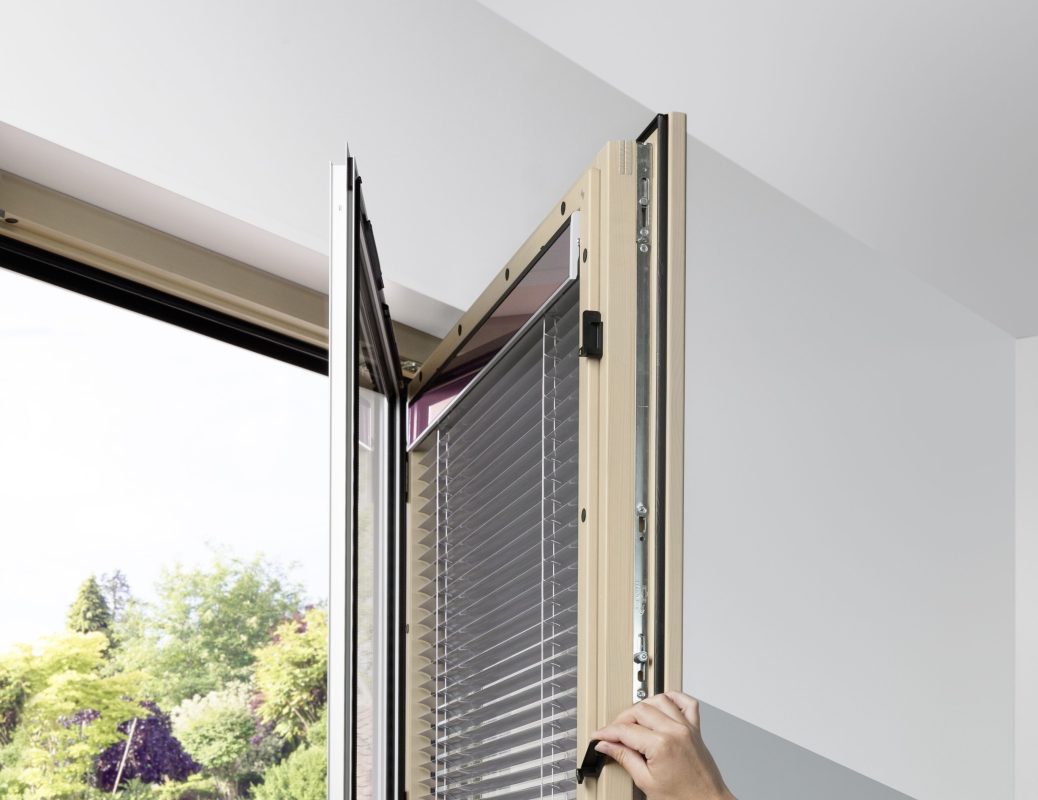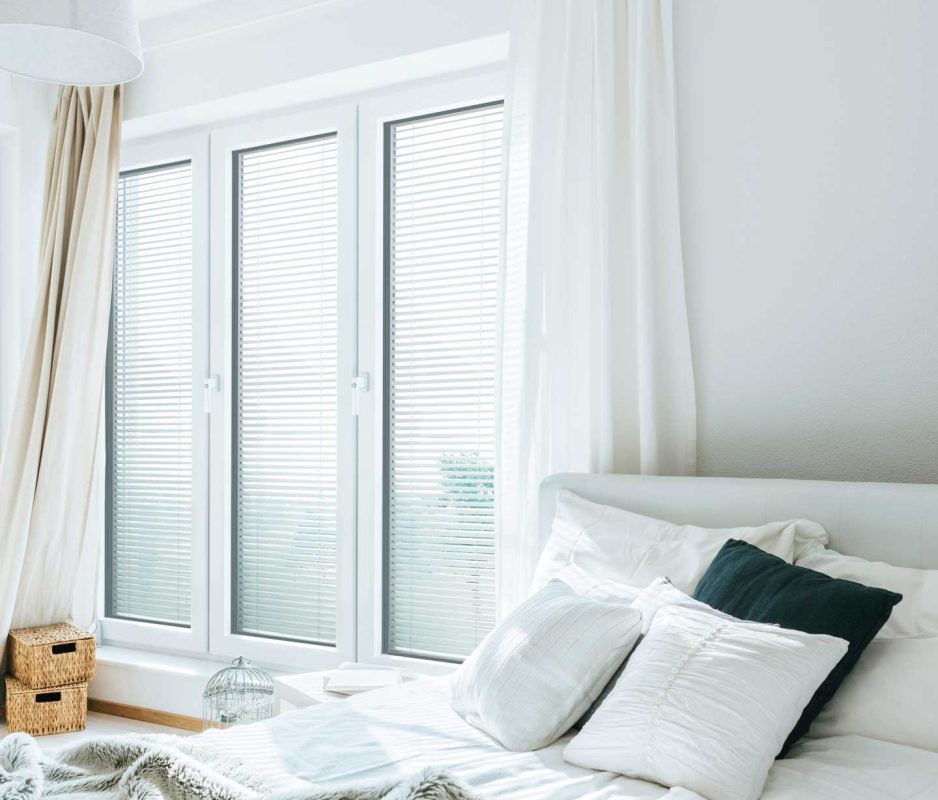In autumn, it is particularly difficult to ensure a pleasant indoor climate. As the days get shorter, the sun is still strong enough to warm up the house during the day, but at night the temperatures can drop to freezing. Internorm’s timber-aluminium and uPVC-aluminium composite windows and doors with accessible integrated blinds offer the solution for both day and night, uniquely combining thermal insulation and shading. In this blog, you can find out how it works and what other advantages the high-tech product from Internorm offers to enjoy warm days and cool nights.

Condensation on early generation windows
Windows with integrated blinds are not a completely new invention. Back in the 1950s, they were touted as an energy-efficient development of the single-glazed options that were still common at the time. Similar to the so-called box windows, they consisted of two parallel window sashes. However, in the case of the windows with integrated blinds, the two sashes were connected and had a common pivot point so that they can be opened and closed together.
Even the early products were far ahead of other windows of this era in terms of thermal insulation. However, they were still manufactured without a gasket. Homeowners therefore complained about the frequent ingress of moisture, especially in winter, which caused condensation to form between the panes and put a strain on the frame material. It was not until the 1980s that windows with gaskets came onto the market, which solved this problem.
Combining outstanding thermal insulation with shading
The new generation of windows with integrated blinds from Internorm, introduced in 1986, provided the answer. With its bespoke design, Internorm windows with blinds differ from other manufactures as the shading is not encapsulated between the glass panes in a sealed glass unit. With Internorm’s KV 440 uPVC-aluminium and HV 450 timber-alumnium composite systems, the window incorporates an additional glass pane that can easily be opened and accessed. Should there be a fault with the blind, the blind unit can easily be accessed, repaired or replaced.
Unlike internal blinds, the additional glass pane and housing for the blinds provides optimum protection from wind, weather and dirt. Internorm’s high performance windows with integrated blinds are available in natural timber-aluminium and uPVC -aluminium and can be matched with other triple-glazed windows and doors from the Internorm range. With a choice of blind options and colours, from Venetian blinds to pleated opaque Duette® blinds, you can match the blinds to your interior and exterior design. The result is a window solution with outstanding thermal insulation and energy efficiency.
A prime example is the HV 450 timber-aluminium composite window, which has a Uw value of just 0.62 W/(m²K). The Uw is a measure for thermal efficiency and is the value that refers to the entire window construction including the frame. The unit ‘watt per square metre Kelvin’ refers to the thermal output that passes through one square metre of a component when the temperature difference between the inside and outside is one degree Kelvin. It is also known as the heat transfer coefficient and should therefore be as low as possible in order to achieve a high energy efficiency. A Uw value of below 0.8 W/(m²K) is deemed as a high-performance window and is particularly suitable for Passivhaus and EnerPHit projects. Integrating suitable shading options is a key consideration in Passivhaus design.
Ideal window for retrofit and renovation projects
The Internorm windows and doors with integrated blinds are particularly popular for replacing windows in retrofit and renovation projects, as privacy and sun protection are already integrated into the product, avoiding the need to for separate sun protection. Another advantage of integrating these windows into retrofit projects is that with the I-tec Shading option, there is no need for an external power source.

I-tec Shading and other advantages
A particular advantage of Internorm windows with integrated blinds is the option of controlling the blinds with I-tec Shading. Without the need for an external power supply, the blinds are powered by a photovoltaic module. When linking it to a Smart Home system, the module recognises day and night and measures the temperature. Depending on the climate and weather situation, the shading is activated to avoid high room temperatures in summer, or the solar energy is used to warm up the interior during cooler months. This is a great advantage, especially in autumn … but not the only one.
Sound insulation: This window solution offers excellent sound insulation of up to 46dB. Reduction in noise pollution has a positive effect on living comfort and mental health, especially in a noisy, urban environment or on a busy road, under a flight path or next to a railway line. Internorm windows are accredited by Quietmark, an organisation focused on reducing noise pollution in the home.
Sun protection: Internorm windows and doors with integrated blinds are particularly popular in bedrooms or bathrooms, where privacy, as well as shading is required. With more people working from home, workspaces will also benefit from sun protection, regardless of the time of year. The benefit of the integrated blinds is that it acts like an external blind rather than an internal blind. The advantage of external, and Internorm integrated blinds, is that they stop the sun from hitting the glass, therefore reducing the heat transferring through the glass into the home.
Privacy: When closed, every sun shading system also provides privacy protection. Especially in the twilight season, you want to protect your home from prying eyes.

Have we piqued your interest? You can find out more about this practical window solution and options available from your nearest Internorm distribution partner. Make an appointment and get expert advice on the best window and door solutions for your project.
